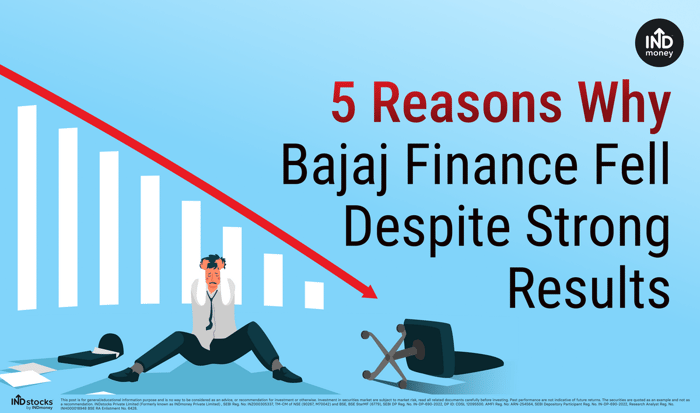
- 1. Leadership Change: Smooth, But Closely Watched
- 2. MSME Lending: Growth Slows as Risk Rises
- 3. Auto Loans (2-Wheelers and 3-Wheelers): Big Drop in Disbursals
- 4. 15.5 Percent of AUM Now Under Cautious Growth View
- 5. Rising NPAs: Risk Still Under Control, But Needs Watching
- Key Highlights
- Final Thoughts: A Shift Toward Caution
Bajaj Finance announced its Q1 FY26 results on 24 July 2025, and on paper, the performance looked impressive. Net profit jumped 22 percent, the asset book (AUM) continued to grow, and more customers were added.
But despite all this, the share price dropped by over 6 percent after the announcement.
Why would a stock fall after strong numbers? The answer lies in the finer details of the results and management commentary. Here's a breakdown of the key reasons investors turned cautious.
1. Leadership Change: Smooth, But Closely Watched
Just three days before the results, on 21 July 2025, Anup Saha stepped down as Managing Director of Bajaj Finance. In response, the board appointed Rajeev Jain (Executive Vice Chairman and an experienced leader) as Managing Director until March 2028.
While the transition was smooth and handled internally, leadership changes in high-valuation financial companies tend to draw attention. It becomes even more important when the company is also sounding cautious on other fronts.
2. MSME Lending: Growth Slows as Risk Rises
The MSME lending segment, known for delivering high returns, faced headwinds this quarter.
AUM from MSMEs: ₹52,538 crore
Share of total AUM: 11.9 percent of ₹4,41,450 crore
Bajaj Finance highlighted rising credit costs in this segment and said growth would now be more measured.
From a risk management point of view, this is a smart decision. But for investors, it also means one of the most profitable lending segments may not grow as fast as before.
3. Auto Loans (2-Wheelers and 3-Wheelers): Big Drop in Disbursals
The company deliberately slowed down 2-wheeler and 3-wheeler loan disbursals, which reflected in the numbers:
2-Wheeler Loan Disbursal: Down 53 percent year-on-year
3-Wheeler Loan Disbursal: Down 57 percent year-on-year
From the Investor Presentation:
"2W and 3W financing business disbursed 104K and 11.1K accounts… degrowth of 53 percent and 57 percent YoY, respectively."
AUM from 2W/3W loans: ₹15,703 crore
Share of total AUM: 3.6 percent
This sharp contraction added to investor concerns that overall loan growth might slow down.
4. 15.5 Percent of AUM Now Under Cautious Growth View
Together, MSME loans and 2W/3W loans make up about 15.5 percent of Bajaj Finance’s total AUM. And both these segments have been flagged for slower growth this year.
| Segment | AUM (₹ Cr) | Share of AUM | FY26 Outlook |
| MSME Lending | 52,538 | 11.9% | Low growth |
| 2W/3W Finance | 15,703 | 3.6% | Slowdown or Degrowth |
These are important lending areas, and the conservative approach, while good for long-term stability, has prompted the market to lower its near-term growth expectations.
5. Rising NPAs: Risk Still Under Control, But Needs Watching
There was a slight rise in asset quality stress:
Gross NPA rose to 1.03 percent from 0.86 percent last year
Net NPA increased to 0.50 percent from 0.38 percent
These levels are still within acceptable limits, and Bajaj Finance continues to maintain strong provisioning. But the upward trend is something to monitor going forward.
Key Highlights
- Net profit rose 22 percent year-on-year, but the stock still fell over 6 percent.
- Leadership change, though internally managed, came just before the results and added some uncertainty.
- MSME and 2W/3W loan segments, which form 15.5 percent of total AUM, are now expected to grow more slowly.
- Sharp drop in 2W/3W loan disbursals, with over 50 percent year-on-year decline in volumes.
- Gross and Net NPAs increased slightly, indicating a marginal rise in portfolio stress.
Final Thoughts: A Shift Toward Caution
Bajaj Finance remains financially strong, well-managed, and respected in the lending space. However, this quarter marked a shift toward caution — both in how it's lending and in how it's managing internal leadership.
The stock market reacts not just to current performance, but also to future expectations. In this case, the market adjusted its outlook, which led to the 6 percent fall in share price.
The next few quarters will be important to see how well the company balances growth with risk management, and how that impacts investor confidence.
Disclaimer
Investments in the securities market are subject to market risks, read all the related documents carefully before investing. The securities are quoted as an example and not as a recommendation.This is nowhere to be considered as an advice, recommendation or solicitation of offer to buy or sell or subscribe for securities. INDStocks SIP / Mini Save is a SIP feature that enables Customer(s) to save a fixed amount on a daily basis to invest in Indian Stock. INDstocks Private Limited (formerly known as INDmoney Private Limited) 616, Level 6, Suncity Success Tower, Sector 65, Gurugram, 122005, SEBI Stock Broking Registration No: INZ000305337, Trading and Clearing Member of NSE (90267, M70042) and BSE, BSE StarMF (6779), SEBI Depository Participant Reg. No. IN-DP-690-2022, Depository Participant ID: CDSL 12095500, Research Analyst Registration No. INH000018948 BSE RA Enlistment No. 6428. Refer https://indstocks.com/pricing?type=indian-stocks; https://www.indstocks.com/page/indian-stocks-sip-terms-and-condition for further details.